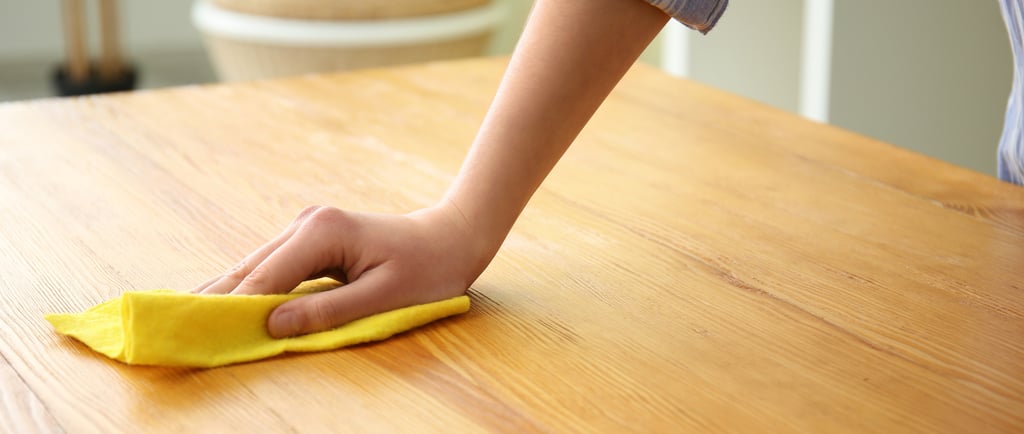Easy Tips to Remove Water Stains from Wood Furniture
Discover simple yet effective methods to eliminate water stains from your wood furniture in our latest blog. From quick DIY fixes using household items to professional restoration tips, this guide offers everything you need to restore and protect your cherished pieces. Whether you're dealing with light surface marks or deep-set stains, these expert tips will help you maintain the beauty and longevity of your wood furniture, ensuring it remains a timeless part of your home.
8/8/20243 min read


Water stains on wood furniture are a common yet frustrating issue for many homeowners. These unsightly marks can mar the beauty of your cherished pieces, leaving you scrambling for a solution. Whether it’s the result of a forgotten coaster or a spill left unattended, water stains are not just a blemish; they can be a sign of potential damage to the wood itself. Early intervention is key to preserving the integrity and appearance of your furniture, ensuring it remains a centerpiece of your home for years to come.
Identifying Water Stains
Water stains on wood furniture typically manifest in two forms: white and dark. White water stains are superficial, indicating that moisture has penetrated only the finish. They are often caused by condensation or minor spills and can usually be addressed with minimal effort. On the other hand, dark water stains suggest that water has seeped deeper into the wood, potentially causing more significant damage. Recognizing the type of stain is crucial as it determines the method of removal.
Preventive Measures
Prevention is always better than cure, especially when it comes to protecting your wood furniture from water stains. Coasters and placemats serve as the first line of defense, creating a barrier between your furniture and potential spills. Additionally, regular maintenance, such as polishing and cleaning, can help safeguard your furniture’s finish, making it more resistant to water damage. Investing a little time in preventive care can save you from the headache of dealing with stubborn water stains later on.
Immediate Actions After Spills
When a spill occurs, the instinct may be to wipe it away quickly. However, blotting is often a better approach. Blotting absorbs the liquid without spreading it across the surface, reducing the risk of the water penetrating deeper into the wood. Using absorbent materials like paper towels or a soft cloth can help minimize immediate damage. Quick action is essential; the longer the water sits on the wood, the greater the risk of staining.
Using Heat to Remove White Water Stains
For those pesky white water stains, applying heat can be an effective remedy. The goal is to evaporate the moisture trapped within the finish. An iron set on a low heat setting, combined with a clean cloth, can work wonders. Alternatively, a hairdryer on a low setting can also do the trick. The key is to move the heat source continuously to avoid damaging the wood. With careful application, the white stains can disappear, restoring your furniture’s original beauty.
The Power of Household Items
Sometimes, the solution to a problem lies within your pantry. Mayonnaise, with its oil content, can help restore moisture balance to the wood, lifting white stains. Apply a small amount, let it sit for a few hours, then wipe it off to see results. Toothpaste, particularly non-gel varieties, can also be used to gently buff out stains. The mild abrasiveness of toothpaste helps remove superficial stains without damaging the finish. These unconventional remedies are surprisingly effective and readily available.
Baking Soda and Water Paste
For a more hands-on approach, a paste made from baking soda and water offers a gentle yet powerful cleaning option. The mildly abrasive nature of baking soda helps remove surface stains without scratching the wood. Apply the paste to the stained area, rub gently with a soft cloth, and then wipe clean. This method is especially useful for treating stains on more delicate finishes where harsher treatments might cause damage.
Removing Dark Water Stains
Dark water stains present a more challenging problem, often requiring more intensive measures. Sanding is one option, though it should be approached with caution. Start with a fine-grit sandpaper to gently remove the top layer of the wood, then refinish the area to match the rest of the piece. Alternatively, wood bleach can be used to lighten dark stains. It’s important to test any bleach on a small, inconspicuous area first to ensure it doesn’t cause further discoloration.
Professional Cleaning and Restoration
When DIY methods fail, or if the damage is extensive, it may be time to call in the professionals. Professional furniture restorers have the tools and expertise to deal with even the most stubborn water stains. They can assess the damage, recommend the best course of action, and restore your furniture to its former glory. While this option may be more costly, it’s worth it for valuable or antique pieces that require specialized care.
Maintaining Your Wood Furniture
Once your furniture is stain-free, it’s essential to maintain its finish to prevent future damage. Regular polishing with a quality wood polish helps preserve the finish, creating a protective layer against moisture. Additionally, keeping your furniture out of direct sunlight and away from sources of heat can prevent the finish from drying out and becoming more susceptible to stains. With proper care, your wood furniture can continue to enhance your home’s aesthetic for years to come.


(609) 806 - 5565
help@freshlivingpc.com
Follow us on
